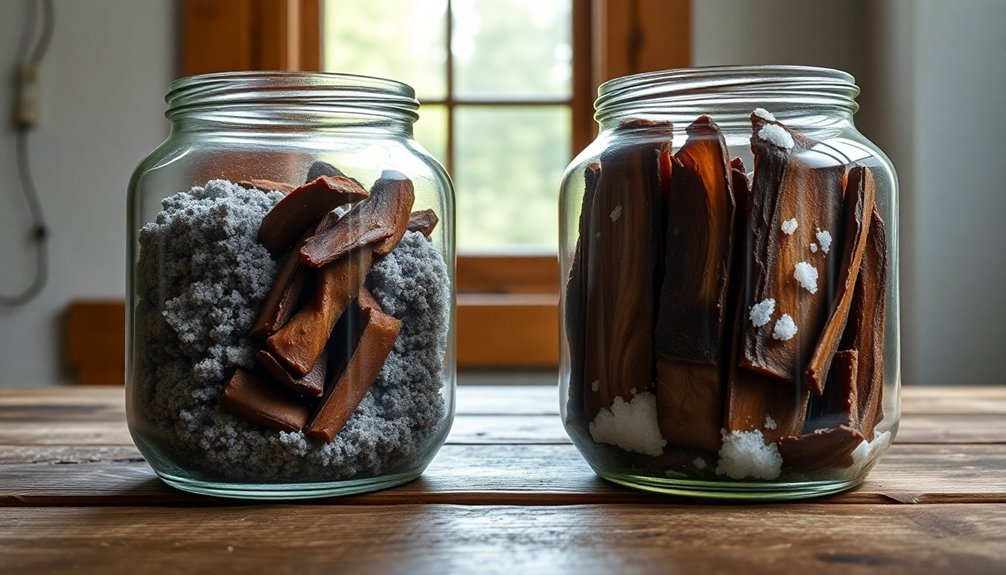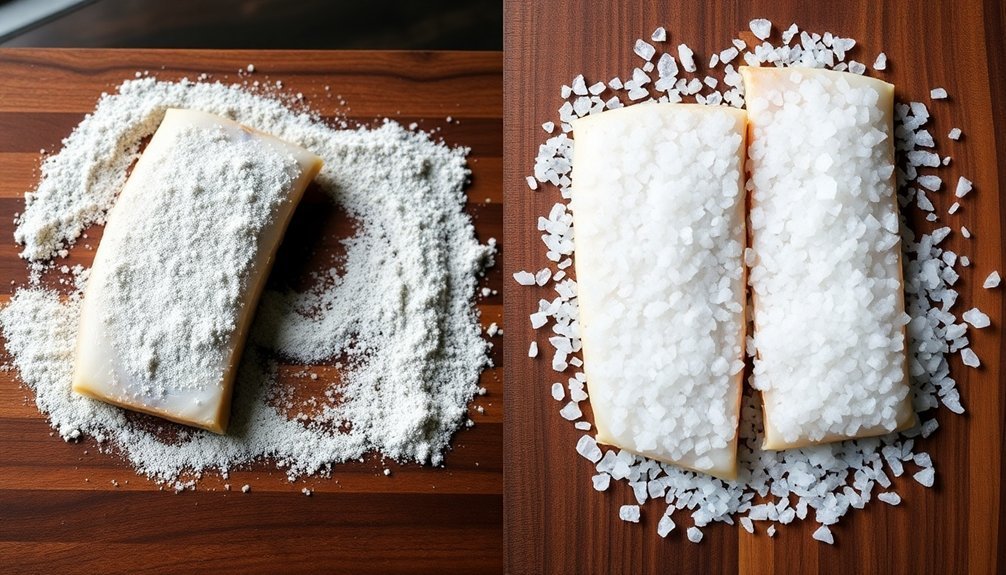Wood ash and salt offer distinct approaches to food preservation that you'll want to understand. While salt preserves through dehydration and osmosis, requiring airtight containers and specific temperature control, wood ash works by creating unfavorable conditions for bacteria while deterring pests naturally. You'll find salt works best for meats and vegetables through brining and pickling, while wood ash excels at preserving eggs, tomatoes, and hard cheeses. Salt greatly alters food textures and adds distinctive flavor, but wood ash maintains original textures while adding subtle smoky notes. Understanding these key differences will help you choose the most effective preservation method for your specific needs.
Preservation Mechanisms and Methods

The fundamental differences between salt and wood ash preservation lie in their core mechanisms of action.
While salt actively disrupts bacterial growth through dehydration and osmosis, wood ash works more passively by creating an unfavorable environment for food spoilage.
Salt's preservation power comes from its ability to draw water out of food cells through osmosis, replacing water molecules with salt ones.
It also disrupts microbial enzymes and DNA, making it impossible for bacteria to survive.
You'll find that salt can reduce water activity below 0.91, effectively stopping most bacterial growth.
Wood ash's preservation methods are less direct.
You'll rely on its ability to create a cool, dark, and dry storage environment.
The ash acts primarily as an insulator and pest deterrent, rather than actively changing the food's cellular structure.
While it can help reduce moisture levels, it's not nearly as effective as salt in this regard.
You can apply salt through various methods like dry curing, brining, or injection, giving you flexibility in preservation techniques.
Wood ash, however, is typically used as a storage medium where you'll place food items directly in or around the ash.
Wood ash preservation has been proven to extend food viability from three months to several years.
Storage Requirements and Conditions
Proper storage conditions mark a critical difference between wood ash and salt preservation methods. While both require cool, dark locations, wood ash offers more flexibility in container choices, including earthenware crockery, cardboard boxes, or even ground holes.
Salt, however, demands strictly airtight containers, with glass jars and plastic containers being the preferred options. Salt can be preserved for indefinite periods when stored correctly in these containers.
You'll find these key storage requirements for both methods:
- Wood ash works as a natural pest deterrent and moisture absorber, making it more forgiving in less-than-perfect storage conditions.
- Salt's hygroscopic nature means it must be kept away from any moisture, as it'll quickly absorb it and become clumpy.
- Wood ash preservation allows for periodic checks and maintenance without compromising the preservation process.
- Salt storage requires consistent conditions and minimal exposure to air or humidity to maintain its effectiveness.
When storing food with wood ash, you can sift the ash for uniformity and distribute it evenly around the food.
With salt, you'll need to focus on maintaining airtight seals and avoiding moisture exposure. Salt storage also requires you to keep it away from cooking odors and steam, which can affect its preservative qualities.
Suitable Foods For Each Method

Preservationists and home cooks alike benefit from understanding which foods work best with each preservation method. Wood ash preservation excels with eggs, certain produce like tomatoes, and hard cheeses such as Gruyere. The Cherokee historically used hickory ash to preserve and flavor their meat. Salt preservation, on the other hand, has been a go-to method for meats, fish, and vegetables through brining and pickling processes. Salt's effectiveness comes from its ability to create osmotic pressure that dehydrates harmful microorganisms.
| Food Category | Wood Ash | Salt |
|---|---|---|
| Meat & Fish | Works with meat, historically used by Cherokee | Excellent for bacon, ham, fish |
| Dairy | Preserves hard cheeses like Gruyere | Essential for cheese making and aging |
| Produce | Good for tomatoes, some other vegetables | Perfect for pickling vegetables |
| Other Items | Excellent for eggs | Great for citrus fruits |
You'll find that salt preservation offers more versatility across food groups, particularly excelling in meat and fish preservation. While wood ash preservation might seem more limited, it provides unique benefits for specific foods like eggs and tomatoes. When choosing between methods, consider that salt preservation often results in a distinctly salty flavor, while wood ash can impart subtle smoky notes to preserved foods.
Impact on Food Texture
Understanding how preservation methods affect food texture can help you choose the right technique for your ingredients.
Wood ash and salt create remarkably different textural outcomes in preserved foods, with salt offering more versatile texture-altering properties.
Salt actively changes food textures through multiple mechanisms. You'll notice it strengthens bread dough, creates protein gels in processed meats, and helps retain moisture in steaks.
It's particularly effective in cheese-making, where it interacts with milk proteins to improve body and texture. When used as a garnish, salt adds a satisfying crunch to foods like pretzels.
Wood ash, however, works differently. Instead of changing textures directly, it primarily preserves existing textures by preventing spoilage.
Its main textural impact is limited to specific foods like acorns, where it helps remove tannins.
Here's what you can expect from each method:
- Salt creates crunchier pickles and crispier vegetable preserves
- Salt enhances bread crust texture through increased caramelization
- Wood ash maintains original textures in hard cheeses
- Wood ash helps preserve foods without greatly altering their texture
Expected Shelf Life Results

Both wood ash and salt demonstrate remarkable differences in their preservation timeframes and effectiveness.
While wood ash typically offers shorter preservation periods of up to 5 weeks for items like tomatoes, salt can preserve foods for months or even years when properly applied.
You'll find that wood ash preservation works best with specific ratios – typically 1.5 kg of ash per 1 kg of food – and shows impressive results compared to untreated foods, with only a 20% decay rate versus 100% in control groups over 5 weeks.
The method particularly shines in areas without refrigeration access and works effectively when you store items in cool, dark places using earthenware containers.
Salt preservation, however, offers you more extended storage possibilities.
When you're preserving meat or fish with salt, you can expect several months to years of shelf life, provided you maintain proper temperature (32-40°F) and humidity (below 70%) conditions.
You'll need to verify you're using pure forms like sea salt or canning salt rather than iodized varieties for peak results.
While both methods are effective, salt preservation generally gives you more flexibility and longer-lasting results for most food types.
Frequently Asked Questions
Can Wood Ash and Salt Preservation Methods Be Combined for Better Results?
You shouldn't combine wood ash and salt preservation methods, as they've different chemical properties that could conflict. Instead, use them separately based on your food type and preservation needs for best results.
How Do You Properly Dispose of Used Wood Ash After Preservation?
You'll need to let used wood ash cool completely for 24-48 hours, then store it in a metal container with a tight lid. You can dispose of it in your regular trash or recycle it as garden fertilizer.
Which Method Is More Cost-Effective for Long-Term Food Storage?
You'll find wood ash more cost-effective for long-term storage since it's free if you're already burning wood. While salt is inexpensive, you'll need to purchase it repeatedly for ongoing preservation needs.
Are Certain Types of Wood Ash Toxic or Unsuitable for Food Preservation?
You shouldn't use wood ash from treated lumber, painted wood, or industrial sources for food preservation, as they contain toxic metals, PAHs, and carcinogens that can contaminate your food and harm your health.
Does the Nutritional Value of Food Change Significantly Between These Preservation Methods?
You'll find wood ash considerably increases mineral content (especially potassium, calcium, and magnesium) in your food, while salt doesn't add nutrients but helps retain existing ones by preventing microbial growth and spoilage.
In Summary
You've learned the key differences between wood ash and salt preservation methods. While salt remains a more versatile and widely-used option, wood ash offers unique benefits for specific foods. Whether you're choosing between these methods, remember to take into account your food type, storage space, and preservation goals. Both techniques can effectively extend shelf life when you properly follow the specific storage and application requirements.





Leave a Reply